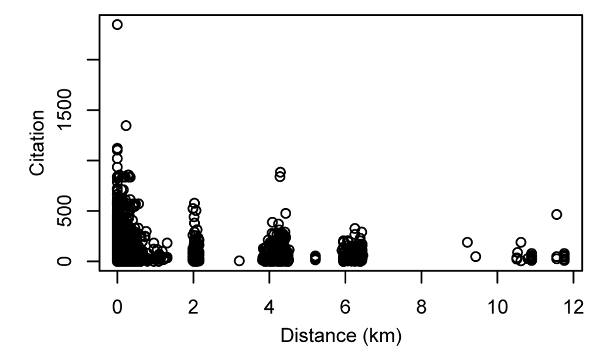Scientific Collaboration
February 8, 2011
It's most common to collaborate with the people who work near you. This statement is probably a close cousin to such memorable
tabloid headlines as, "Winter ice may be slippery, scientists say." I was sole author of twenty-six of my
fifty-three publications. If you just examine multiple author papers, I had 33 co-authors who were located in my same research building, and 21 who were located elsewhere, either at universities, or at other company locations. So, my local co-authors outnumbered remote co-authors by about 3:2. A recent paper in
PLoS One[1-4] went beyond this obvious observation to investigate whether collaboration with outsiders was more beneficial to your career than collaboration with colleagues who are nearby.
I would have thought that papers written with remote collaborators would lead to publications with a greater number of
citations; but the opposite was found by a research team from the Center for Biomedical Informatics and the Department of Operations and Business Affairs,
Harvard Medical School; and the Children's Hospital Informatics Program at the
Harvard-
MIT Division of Health Sciences and Technology. Since the research was done at Harvard, they looked at articles in
biomedical science with at least two authors, one of whom was a Harvard scientist, from 1993-2003.
Going to somewhat of an extreme, they determined the
three-dimensional location of the authors through use of building floor plans and building directories.[4] This allowed a distance calculation for offices separated by floors in the same building. Armed with the citation and distance data, they looked at correlations between first and last author for two author papers; and first-middle, last-middle, and middle-middle authors where applicable.
In what appears to be the first study of this type,[2] the Harvard team used data from 35,000 articles in 2,000 journals by 200,000 authors.[3] The citation rate decreased as first-last author distance increased for the subset of distance less than one
kilometer. This correlation held true at other distance scale subsets, including same building, same city and different city). As a type of self-calibration, this correlation wasn't seen for first-middle, last-middle, and middle-middle authors. As the figure shows, the correlation is apparent, although not imperative. Probably not much better can be expected from social data such as these.

Scatter plot of distance between authors and citation for Harvard authors, who are in four geographical locations. (Fig. 2 of Ref. 1)
Author order on scientific papers usually follows the rule that the "
mentor," usually the
graduate student's professor, is listed as the last author. The guy who does all the work (a.k.a., graduate student) is listed first. There are some notable exceptions.
Victor Weisskopf always insisted on an
alphabetical order of authors. Weisskopf's name was always last, except when he coauthored a paper with Eugene Wigner.
Everyone seems to be counting on
electronic and social networking as a means of enhancing collaboration, but it appear that "face-time" is as important today as in the past. Says Isaac Kohane, Director of the Countway Library of Medicine at Harvard Medical School and an author of this study,
"Despite all of the profound advances in information technology, such as video conferencing, we found that physical proximity still matters for research productivity and impact."[4]
The study found that papers with four or fewer authors who were located in the same building were cited 45% more than if the authors were in different buildings.[4] Paper with more than four authors are usually the result of large collaborations whose research is likely to be cited often because of the topic area, irrespective of where the authors reside. Although the study authors speculate that these findings might help in the design of research centers,[4] I think most such centers are already laid out fairly well to promote collaboration. The only problems might be where corporate penny-pinching might override common sense planning; e.g.,
cubicle farms for scientists.
Kohane and first author Kyungjoon Lee started this project when their offices were on different floors. When Kohane moved his office to Lee's floor, Lee remarked that Kohane became a lot more helpful.[2]

A former nexus of scientific collaboration - My former office (Latitude: 40.7913
Longitude: -74.44328).
Note the voluminous stacks of reference materials. Today's Internet makes things much easier.
![]()
References:
- Kyungjoon Lee, John S. Brownstein, Richard G. Mills and Isaac S. Kohane, "Does Collocation Inform the Impact of Collaboration?" PLoS ONE, vol. 5, no. 12 (December 15, 2010), e14279.
- Richard Van Noorden, "Love thy lab neighbour," Nature, vol. 468, no. 7327 (December 23, 2010), p. 1011.
- Katie DuBoff, "Nearer, better - Link found between physical proximity of researchers, impact of work," Harvard Medical School Communications, December 15, 2010.
- Jen Laloup, "Close proximity leads to better science," Public Library of Science Press Release, December 15, 2010.
Permanent Link to this article
Linked Keywords: Tabloid; PLoS One; citation; Harvard Medical School; Harvard; MIT; biomedical science; Global Positioning System; GPS; kilometer; Author order; mentor; graduate student; professor; Victor Weisskopf; alphabetical order of authors; electronic and social networking; cubicle farm; nexus.